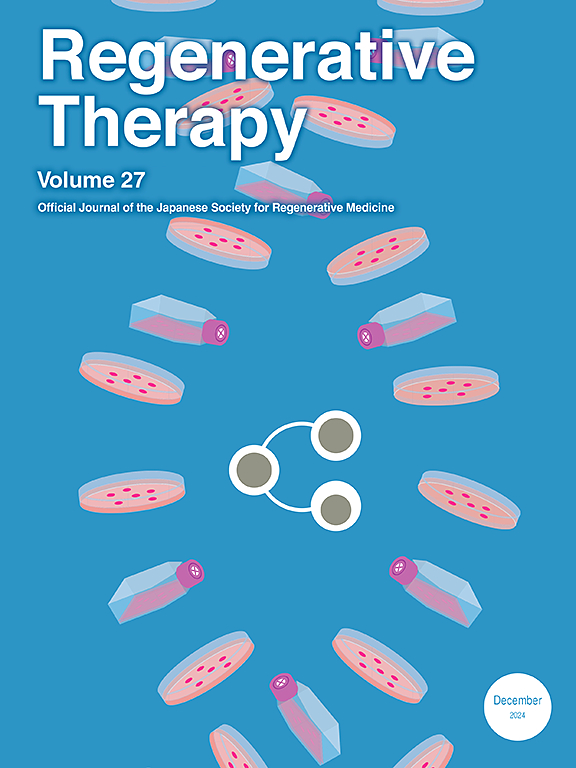利用人胚胎干细胞衍生类器官在微流控芯片上模拟软骨内成骨初期的血管动力学。
IF 3.4
3区 环境科学与生态学
Q3 CELL & TISSUE ENGINEERING
引用次数: 0
摘要
血管相互作用在胚胎发生,包括骨骼发育中起着至关重要的作用。在软骨内成骨过程中,间充质细胞凝聚形成血管网络,随后侵入骨骼元件形成骨髓。我们和其他研究小组通过将人胚胎干细胞(hESC)衍生的硬核组植入免疫缺陷小鼠,建立了软骨内成骨模型。然而,软骨内成骨的体外模型,特别是初始阶段血管与间充质细胞的相互作用,尚未建立。因此,我们开发了一种方法,使用基于微流控芯片的平台来模拟软骨内成骨的初始阶段,特别关注血管相互作用。在芯片上,我们发现纤维蛋白凝胶比胶原- 1凝胶更有助于排列表达mccherry的人脐静脉内皮细胞(HUVECs),这表明纤维蛋白凝胶更适合血管样网络的形成。使用异硫氰酸荧光素-葡聚糖和荧光微珠部分证实了血管样网络的灌注性。然后,我们将hesc衍生的硬核组与增强的绿色荧光蛋白(EGFP)表达的HUVECs混合,并将这种混合物应用于芯片上。我们将这种细胞混合物命名为类SH器官。与芯片上的核切面球体相比,SH类器官在维持由表达mccherry的HUVECs形成的血管样网络方面表现出更强的能力。表达egfp的huvec从SH类器官迁移,形成血管样网络,并与芯片上表达mccherry的血管样网络部分相互作用。组织学分析显示,SRY-box转录因子9 (SOX9)和I型胶原蛋白分别在浓缩间充质细胞和软骨膜样细胞中相互排斥表达。这项研究表明,我们的SH类器官芯片方法可以复制软骨内成骨初始阶段形成的血管网络。该模型可能为人类软骨内成骨提供新的见解,并在骨病建模和药物筛选方面具有潜在的应用价值。本文章由计算机程序翻译,如有差异,请以英文原文为准。
Modeling vascular dynamics at the initial stage of endochondral ossification on a microfluidic chip using a human embryonic-stem-cell-derived organoid
Vascular interactions play a crucial role in embryogenesis, including skeletal development. During endochondral ossification, vascular networks are formed as mesenchymal cells condense and later invade skeletal elements to form the bone marrow. We and other groups developed a model of endochondral ossification by implanting human embryonic stem cell (hESC)-derived sclerotome into immunodeficient mice. However, in vitro models of endochondral ossification, particularly vascular interaction with mesenchymal cells at its initial stage, are yet to be established. Therefore, we developed a method to model the initial stage of endochondral ossification using a microfluidic chip-based platform, with a particular focus on the vascular interaction. On the chip, we found that the fibrin gel helped align mCherry-expressing human umbilical vein endothelial cells (HUVECs) better than the collagen-I gel, suggesting that the fibrin gel is more suitable for the formation of a vascular-like network. The perfusability of the vascular-like networks was partially confirmed using fluorescein isothiocyanate (FITC)-dextran and fluorescent microbeads. We then mixed hESC-derived sclerotome with enhanced green fluorescent protein (EGFP)-expressing HUVECs and applied this mixture on the chip. We named this mixture of cells SH organoids. The SH organoids showed superior abilities to maintain the vascular-like network, which was formed by the mCherry-expressing HUVECs, compared with the sclerotome spheroids on the chip. The EGFP-expressing HUVECs migrated from the SH organoid, formed a vascular-like networks, and partially interacted with the mCherry-expressing vascular-like networks on the chip. Histological analysis showed that SRY-box transcription factor 9 (SOX9) and type I collagen were expressed mutually exclusively in the condensed mesenchymal cells and perichondrial-like cells, respectively. This study demonstrates that our SH organoid-on-a-chip method reproduces vascular networks that are formed at the initial stage of endochondral ossification. This model may provide insights into human endochondral ossification and has potential applications in bone disease modeling and drug screening.
求助全文
通过发布文献求助,成功后即可免费获取论文全文。
去求助
来源期刊

Regenerative Therapy
Engineering-Biomedical Engineering
CiteScore
6.00
自引率
2.30%
发文量
106
审稿时长
49 days
期刊介绍:
Regenerative Therapy is the official peer-reviewed online journal of the Japanese Society for Regenerative Medicine.
Regenerative Therapy is a multidisciplinary journal that publishes original articles and reviews of basic research, clinical translation, industrial development, and regulatory issues focusing on stem cell biology, tissue engineering, and regenerative medicine.
 求助内容:
求助内容: 应助结果提醒方式:
应助结果提醒方式:


